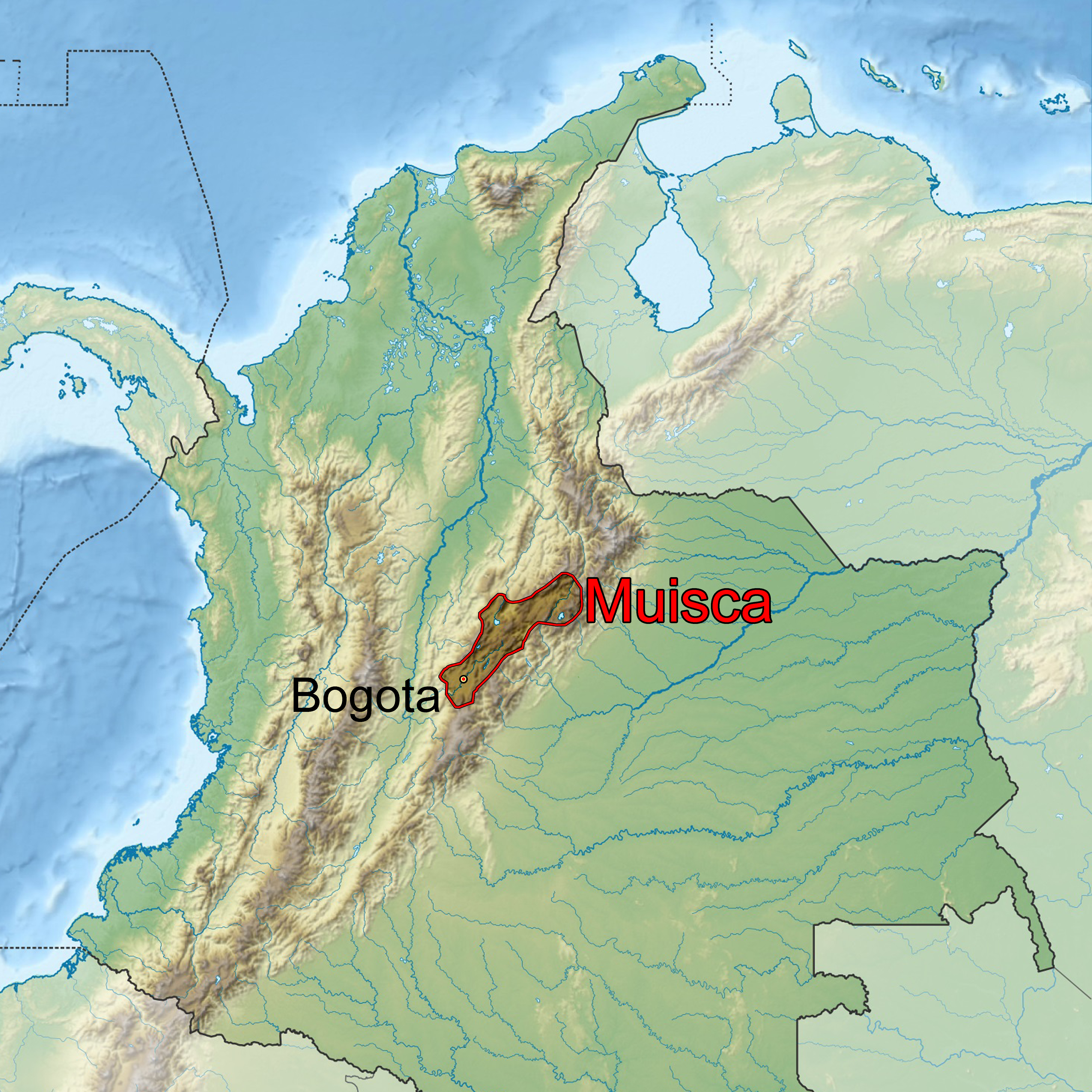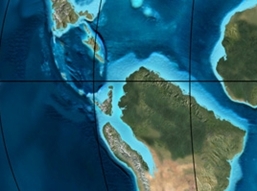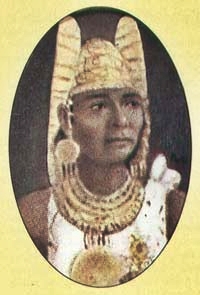|
Lake Guatavita
Lake Guatavita (Spanish: ''Laguna Guatavita'') is located in the Cordillera Oriental of the Colombian Andes in the municipality of Sesquilé in the Almeidas Province, Cundinamarca department of Colombia, northeast of Bogotá, the capital of Colombia. The lake is circular and has a surface area of . The earlier theories of the crater's origin being a meteorite impact, volcanic cinder, or limestone sinkhole are now discredited. The most likely explanation is that it resulted from the dissolution of underground salt deposits from an anticline, resulting in a kind of sinkhole. There are hot springs nearby in the municipality of Sesquilé, which means "hot water" in the now-extinct language of Chibcha, once spoken by the local indigenous people, the Muisca. Spanish colonizers and Conquistadors knew about the existence of a sacred lake in the Eastern Ranges of the Andes possibly as early as 1531. The lake was associated with indigenous rituals involving gold. However, the firs ... [...More Info...] [...Related Items...] OR: [Wikipedia] [Google] [Baidu] |
Muisca Raft Legend Of El Dorado Offerings Of Gold
The Muisca (also called the Chibcha) are indigenous peoples in Colombia and were a Pre-Columbian culture of the Altiplano Cundiboyacense that formed the Muisca Confederation before the Spanish colonization of the Americas. The Muisca speak Muysccubun, a language of the Chibchan language family, also called ''Muysca'' and ''Mosca''. The first known contact with Europeans in the region was in 1537 during the Spanish conquest of New Granada. In New Spain, Spanish clerics and civil officials had a major impact on the Muisca, attempting to Christianize and incorporate them into the Spanish Empire as subjects. Postconquest Muisca culture underwent significant changes due to the establishment of the New Kingdom of Granada. Sources for the Muisca are far less abundant than for the Aztec Empire of Mesoamerica or the Inca Empire and their incorporation to the Spanish Empire during the colonial era. In the New Kingdom of Granada and into the colonial era, the Muisca became "the of ... [...More Info...] [...Related Items...] OR: [Wikipedia] [Google] [Baidu] |
Altiplano Cundiboyacense
The Altiplano Cundiboyacense () is a high plateau located in the Eastern Cordillera of the Colombian Andes covering parts of the departments of Cundinamarca and Boyacá. (Do not confuse with The Altiplano or the Altiplano Nariñense, both further south.) The altiplano corresponds to the ancient territory of the Muisca. The Altiplano Cundiboyacense comprises three distinctive flat regions; the Bogotá savanna, the valleys of Ubaté and Chiquinquirá, and the valleys of Duitama and Sogamoso. The average altitude of the altiplano is about above sea level but ranges from roughly to . Etymology ''Altiplano'' in Spanish means "high plain" or "high plateau", the second part is a combination of the departments Cundinamarca and Boyacá. Geography The limits of the Altiplano are not strictly defined. The high plateau is enclosed by the higher mountains of the Eastern Ranges, with the Sumapaz mountains in the south and Chingaza to the east. The Tenza Valley is locate ... [...More Info...] [...Related Items...] OR: [Wikipedia] [Google] [Baidu] |
Sacred Waters
Sacred waters are sacred natural sites characterized by tangible topographical land formations such as rivers, lakes, spring (hydrosphere), springs, Water reservoir, reservoirs, and oceans, as opposed to holy water which is water elevated with the sacramental blessing of a cleric. These organic bodies of water have attained religious significance not from the modern alteration or blessing, but were Sanctification, sanctified through mythological or historical figures. Sacred waters have been exploited for cleansing, healing, initiations, and Ritual#Death, mourning, and funerary rites, death rites. Ubiquitous and perpetual fixations with water occur across religious traditions. It tends to be a central element in the creations accounts of almost every culture with mythological, cosmological, and theological myths. In this way, many groups characterize water as "living water", or the "water of life". This means that it gives life and is the fundamental element from which life arises ... [...More Info...] [...Related Items...] OR: [Wikipedia] [Google] [Baidu] |
Lake Iguaque
Lake Iguaque is a lake located in the Boyacá Department of Colombia. The lake and the surrounding area was declared a Flora and Fauna Sanctuary in 1977. Geography and climate Lake Iguaque is located northeast of Villa de Leyva and is part of the SFF Iguaque. The predominant ecosystem is the páramo, with presence of frailejón plant, ferns, lichens and puyas. The average temperature is 12 °C. The route of access to the natural reservation is: Bogotá – Tunja (147 km) /Tunja – Villa de Leyva (39 km). The visitor center Furachiogua offers accommodation for up to 48 persons, and camping zone. Cultural value Lake Iguaque was considered a sacred place for the Muisca. According to legend, mankind was originated in the Iguaque lake, when the goddess Bachué came out from the lake with a boy in her arms. When the boy grew, she married him and their children populated the Earth. They are considered the ancestors of the human race. Finally Bachué and her husband ... [...More Info...] [...Related Items...] OR: [Wikipedia] [Google] [Baidu] |
Women In Muisca Society
This article describes the role of women in Muisca society. The Muisca were the original inhabitants of the Altiplano Cundiboyacense (present-day central Colombian Andes) before the Spanish conquest in the first half of the 16th century. Their society was one of the four great civilizations of the Americas. Women held an important and largely egalitarian role in Muisca society. While men were responsible for hunting, warfare, and other activities, women took charge of sowing the fields, preparing food and chicha, and educating children. Both men and women participated in religious rituals. The most important deities in Muisca culture were female: Chía, the goddess of the Moon; Huitaca, the goddess of sexual liberation; and Bachué, the mother goddess of the Muisca people. While the first chroniclers during the period of conquest and early colonization—such as Gonzalo Jiménez de Quesada, Pedro Simón, Juan de Castellanos and Lucas Fernández de Piedrahita—were all m ... [...More Info...] [...Related Items...] OR: [Wikipedia] [Google] [Baidu] |
Muisca Religion
Muisca religion describes the religion of the Muisca people, Muisca who inhabited the central highlands of the Colombian Andes before the Spanish conquest of the Muisca. The Muisca formed a Muisca Confederation, confederation of holy Muisca rulers, rulers and had a variety of deity, deities, temples and rituals incorporated in their culture. Supreme being of the Muisca was Chiminigagua who created light and the Earth. He was not directly honoured, yet that was done through Chía (goddess), Chía, goddess of the Moon, and her husband Sué, god of the Sun. The representation of the two main celestial bodies as husband and wife showed the complementary character of man and Women in Muisca society, woman and the sacred status of marriage.Muisca religion - Pueblos Originarios - accessed 04-05-2016 The Muisca worshipped the ... [...More Info...] [...Related Items...] OR: [Wikipedia] [Google] [Baidu] |
Fanny Lú
Fanny Lucía Martínez Buenaventura (born 8 February 1973), better known professionally as Fanny Lu, is a Colombian singer, songwriter, and actress from Santiago de Cali, Colombia. She studied at the University of the Andes and received a degree in industrial engineering. She is the mother of two children, Mateo and Valentina. Fanny Lu's first job in the entertainment industry was in Colombia, as a hostess to a music magazine called ''Siempre Música''. She then moved on to radio voice in the principal radio stations from her country. However, she wasn't recognized until 1998, when she made part of the cast of the Colombian soap opera ''Perro Amor''. In 2006, Fanny Lu released Lágrimas Cálidas, winning fame in Colombia and some countries from Latin America, with her two singles that reached the top of the Latin charts. Her 2008 album ''Dos'' consolidated her music career, giving her credibility as an artist. Her single " Tú No Eres Para Mi" was number one in several countr ... [...More Info...] [...Related Items...] OR: [Wikipedia] [Google] [Baidu] |
No Te Pido Flores
No Te Pido Flores ("I'm Not Asking You For Flowers") is the debut song by Colombian singer Fanny Lu on her first studio album '' Lágrimas Cálidas'' (2006). The song received a Billboard Music Latin nomination for " Tropical Airplay of the Year" and a Latin Grammy nomination for " Best Tropical Song". Song information The song was written by the Colombian producer José Gaviria, who defined to Fanny Lu as the only female voice with success within the so-called Tropipop scene. "No Te Pido Flores" is a mix of tropical rhythms with vallenato and Latin pop. The lyrics deal with heartbreak and disappointment over a previous relationship. In the chorus: "No te pido que traigas flores/ Tampoco que me des bombones/ Yo solo quiero una caricia/ Que me digas que tu me quieres." ("I'm not asking you to bring me flowers/ Nor to give me sweets/ I just want a caress/ That you tell me how much you love me.") she sings about how love is about actions and not gifts, and Lu has decided to forge ... [...More Info...] [...Related Items...] OR: [Wikipedia] [Google] [Baidu] |
Music Video
A music video is a video that integrates a song or an album with imagery that is produced for promotion (marketing), promotional or musical artistic purposes. Modern music videos are primarily made and used as a music marketing device intended to promote the sale of music recordings. These videos are typically shown on music television and on streaming video sites like YouTube, or more rarely shown theatrically. They can be commercially issued on home video, either as video albums or video singles. The format has been described by various terms including "illustrated song", "filmed insert", "promotional (promo) film", "promotional clip", "promotional video", "song video", "song clip", "film clip", "video clip", or simply "video". While musical short, musical short films were popular as soon as recorded sound was introduced to theatrical film screenings in the 1920s, the music video rose to prominence in the 1980s when American TV channel MTV based its format around the medium. Mus ... [...More Info...] [...Related Items...] OR: [Wikipedia] [Google] [Baidu] |
Gold
Gold is a chemical element; it has chemical symbol Au (from Latin ) and atomic number 79. In its pure form, it is a brightness, bright, slightly orange-yellow, dense, soft, malleable, and ductile metal. Chemically, gold is a transition metal, a group 11 element, and one of the noble metals. It is one of the least reactivity (chemistry), reactive chemical elements, being the second-lowest in the reactivity series. It is solid under standard temperature and pressure, standard conditions. Gold often occurs in free elemental (native state (metallurgy), native state), as gold nugget, nuggets or grains, in rock (geology), rocks, vein (geology), veins, and alluvial deposits. It occurs in a solid solution series with the native element silver (as in electrum), naturally alloyed with other metals like copper and palladium, and mineral inclusions such as within pyrite. Less commonly, it occurs in minerals as gold compounds, often with tellurium (gold tellurides). Gold is resistant to ... [...More Info...] [...Related Items...] OR: [Wikipedia] [Google] [Baidu] |
List Of Conquistadors In Colombia
This is a list of conquistadors who were active in the conquest of terrains that presently belong to Colombia. The nationalities listed refer to the state the conquistador was born into. Granada and Castile are currently part of Spain, but were separate states at the time of birth of the early conquistadors. Important conquistadors and explorers were Alonso de Ojeda, who landed first at Colombian soil and founded the first settlement ''Santa Cruz'',Personajes de la Conquista a América – Banco de la República |
Zipa
When the Spain, Spanish arrived in the central Colombian highlands, the region was organized into the Muisca Confederation, which had two rulers; the ''Zipa'' was the ruler of the southern part and based in Funza, Muyquytá. The ''Zaque'' was the ruler of the northern area and based in Tunja, Hunza, known today as Tunja. Organization ''Zipa (Psihipqua)'' and ''Zaque (Hoa)'' were the titles given to these rulers of the ancient confederation. Neither exercised absolute power, not rigid or strict control over those to whom they owed their power, so that they can be considered kings. However, these positions of power were of great honor and were surrounded by a rather elaborate ceremony. The position of the ''Zipa'' was such that not even the members of the nobility dared to look him in the face, and it is said if the ''Zipa'' needed to spit, someone would hold out a piece of rich cloth for him to spit on, because it would be sacrilegious for anything so precious as his saliva to to ... [...More Info...] [...Related Items...] OR: [Wikipedia] [Google] [Baidu] |







